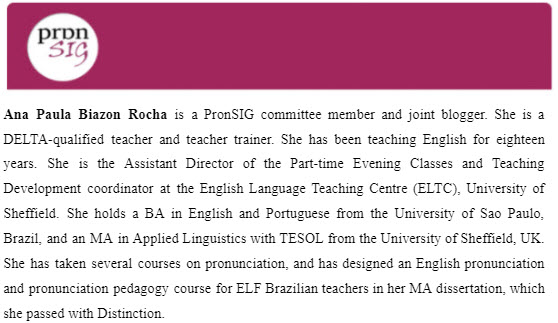by Ana Paula Biazon Rocha
‘Of all the aspects of language – vocabulary, grammar, pronunciation, spelling, the four skills and so on – pronunciation is probably the one that needs least teaching’ (Ur, 2016, p. 74)
Teaching pronunciation is a recurrent theme in ELT, but one which can sometimes lead to mixed feelings: while some defend it vehemently, others question its value; where some feel extremely confident about it, others run away from it as quickly as possible. This might be because pronunciation involves such a variety of linguistic, cognitive, psychological, cultural and geopolitical aspects, which might be more than we can fathom. Surprisingly, I have come across a text recently which made me consider the possible motivations and common beliefs behind it.
In the 2016 book, 100 Teaching Tips (CUP), Ur comments that among the language skills and systems, ‘pronunciation is probably the one that needs least teaching’ (p. 74), but what does she mean by that?
One of the key points to analyse why these ideas seem to be widespread in our field, and not only Ur’s view, is that pronunciation tends to be seen as an extra component in the classroom. Facilitating students’ learning of the language, such as grasping the meaning of new vocabulary, making sense of grammar rules, being able to express their opinions clearly, organising ideas into coherent and cohesive writing, reading and interpreting a text, developing listening strategies, among many others, is no easy task. As a result, whether learners say imporTANT instead of imPORtant may become the least of our worries.
Another frequent assumption is that learners are able to pick up things by themselves, incidentally. This can happen and I am a living proof of that because of the intense exposure I had and still do to music, films, TV shows, books, Internet, etc., which made me learn English much quicker than if I ever tried to do it without these sources. Similarly, Krashen’s (1985) input hypothesis also deems exposure to the language, or input, as paramount in the language acquisition process. Despite this, assuming things could be risky and misleading. What works for me, might not work for you, and vice-versa. The amount of exposure that each student has to English varies, and their ability to pick up things and learn by themselves might be their greatest difficulty. We are all different and we all have different needs.
Accordingly, pronunciation is about muscle, mind, memory, and meaning (Hancock, 2019); it is extremely physical (Underhill, 2019). If you need someone to help you learn how to ride a bike or cook, you also need the teacher to teach you how to pronounce English clearly. Notice that I am not using the word “correctly” because it is an extremely evasive term in our field, nor am I using the idea of “pronouncing like a native-speaker” because the focus of pronunciation teaching, as Ur (2016) points out, has thankfully changed to ‘being able to communicate in a variety of situations worldwide, usually with other people whose mother tongue is not English’ (p. 74). In other words, intelligibility is key when teaching pronunciation (Hancock, 2020).
Therefore, pronunciation should not be an extra in our lessons but an essential part of it, integrated into everything we do (see our previous posts about how to integrate pronunciation and the four skills here and here). Moreover, research demonstrates that pronunciation instruction does contribute to learners being able to communicate more effectively (Derwing & Munro, 2015; Levis et al., 2022). For this reason, it should not be a matter of how little or how much pronunciation should be taught but that it should be taught. We do not teach writing in detriment of speaking, or listening in detriment of reading, or vocabulary in detriment of grammar, we teach language, and language teaching amalgamates all these elements, including pronunciation.
Finally, I agree with Ur (2016) that we should focus on students’ particular needs and difficulties when it comes to pronunciation, but “teaching pronunciation (a little)” (p. 74) should be much more than remedial work.
Maybe now the one-million-dollar question is: how to teach pronunciation? That is the core of the PronSIG’s blog, and if you have not had a chance to check our previous posts and make use of our tips, discussions and examples yet, better late than never!
Don’t forget to follow PronSIG on social media and leave your comment below.
References
Derwing, T., & Munro, M. (2015). Pronunciation fundamentals: Evidence-based perspectives for L2 teaching and research. Amsterdam: John Benjamins.
Hancock, M. (2019). “Pronunciation: muscle, mind, meaning, memory”, English Teaching Professional, 22. Available at: http://hancockmcdonald.com/ideas/pronunciation-muscle-mind-meaning-memory. Accessed on 27 Jan 2020.
Hancock, M. (2020). 50 Tips for Teaching Pronunciation. Cambridge: Cambridge University Press.
Krashen, S. (1985). The Input Hypothesis: Issues and Implications. Longman ELT.
Levis, J., Derwing, T. & Sonsaat-Hegelheimer, S. (2022). Second Language Pronunciation. Bridging the Gap Between Research and Teaching. Hoboken and West Sussex: Wiley Blackwell.
Underhill, A. (2019). My Top Ten Pronunciation Tips: Physicality and Integration. Available at: https://www.oxfordtefl.com/blog/my-top-ten-pronunciation-tips-physicality-and-integration-by-adrian-underhill. Accessed on 07 March 2020.
Ur, P. (2016). 100 Teaching Tips. Cambridge: Cambridge University Press.


